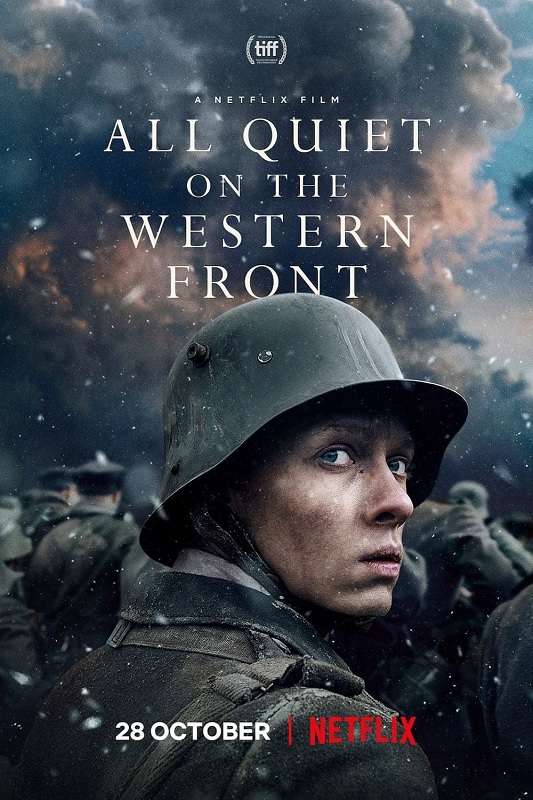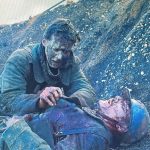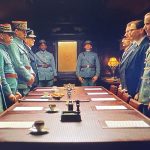

2022 – All Quiet on the Western Front
The first version of this film that was nominated for Best Picture was all the way back in 1930 at the third Academy Awards, the biggest difference being that in 1930, it won. But I think this film is far superior to its predecessor, not because of its production values, but because it has a more cohesive script. There was more of a linear story that was easier to follow. It gave more attention to character motivations and examined the plot from more diverse angles.
In fact, this is the third film adaptation of the story, the other being a made for TV version that was aired in 1979, which I have not seen. And granted, it has been a long while since I have seen the 1930 version, but I do remember the ending, which was very different than the one we got here in 2022. But I’ll get to that in a moment, though I will mention that it was the 1930 ending that more closely resembled the book of the same name that was published in 1929.
The story is about Paul Baumer, a young ordinary German man who signs up to fight in World War One along with his schoolmates, their heads full of patriotism, and dreaming of honor and glory. But it doesn’t take long for them to learn of the true horrors of trench warfare on the Western Front and death. As Paul and his comrades are put through battle after pointless battle, some dying, and all of them becoming emotionally scarred, their dreams of a glorious victory die, and are replaced by severely damaged spirits.
In contrast to the earlier versions of the story, here, Paul’s friends are given personalities and personal motivations, which is a good thing. It makes their deaths more impactful. In a few cases, we don’t even see their deaths. We are just shown things like a pair of special glasses or a bloody scarf, that indicate violent ends. Another difference in this film adaptation is that we are given scenes with the diplomats and generals who are in peace talks to end the bloody conflicts. When it is clear that Germany is losing the war, some of them sue for surrender and peace, while others, uncaring of the staggering number of deaths in the common soldiery, cannot accept defeat and surrender.
The actor playing Paul Baumer was Felix Kammerer, and boy was he put through the ringer. Oddly enough, there weren’t many intense battle sequences, though there were a few. But his most intense scenes were ones in which he learns of his friends dying, or when he kills a French soldier in terrible hand-to-hand combat. He is often shown with so much mud caked on his face that he looks like a zombie in a horror film, which was most certainly intentional. With his soul killed by his participation in the war, he becomes like a walking dead man.
Actors Aaron Hilmer, Moritz Klaus, Adrian Grünewald, and Edin Hasanovic, played his friends, Albert Kropp, Franz Müller, Ludwig Behm, and Tjaden Stackfleet, all of whom died in various ways, the most notable of which was Tjaden, who committed suicide rather that live the rest of his life as a cripple, by stabbing himself several times in the throat with a fork, a death which Paul witnesses.
But it was Paul’s best friend, Stanislaus “Kat” Katczinsky, played by Albrecht Schuch, who really stood out. Kat was a more seasoned soldier who Paul meets before his first battle, who becomes somewhat of a mentor to the new recruits. His acting stood out to me as incredible, especially during a scene where he tells Paul of his young son who had died of the pox. It was a moment of vulnerability that was very touching, and really allowed us to get to know him. And while his eventual death was different than in the 1929 novel and the 1930 movie, it was nonetheless just as poignant.
But it was the final battle that was the most heartbreaking. With only fifteen minutes to go before the end of the war, General Friedrichs, played by Devid Striesow, unwilling to accept a German surrender or defeat, orders his men to attack the French. If only the peace could have been maintained for those last few minutes, Paul would have survived. Instead, he is stabbed through the back by a bayonet seconds before the war ends, and a cease-fire is declared. His face is caked with so much dirt and dust, he looks like a ghost.
But I think the biggest difference between this movie and the source material is that final scene. In the novel, there is no last minute attack, no battle. Paul is killed on a peaceful, ordinary day. He has been so damaged by the war that he no longer feels like he has a place in the peaceful world, and his corpse is found with a calm expression on his face, as if he welcomed death. Here the ending was altered to emphasize the devastating waste and pointlessness of war, and the pathetic, petty reasons for forcing young men to die in battles fought for uncaring leaders. But one thing each adaptation of this story have in common, is that they are all strongly anti-war. They all show scenes of graphic violence and the horrific physical and emotional consequences of taking part in such conflicts.








